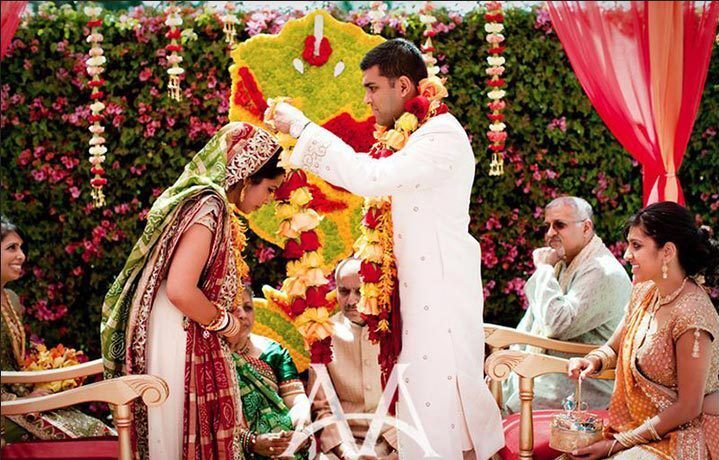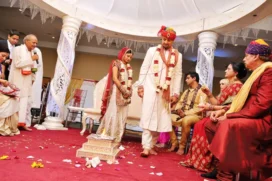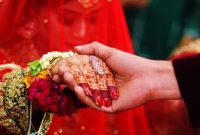The Complete Guide to Hindu Marriage Types and How They Differ
What is Hinduism?
Hinduism is one of the oldest religions in the world that originated in India. It is a polytheistic religion with a diverse range of beliefs and practices. The followers of Hinduism are called Hindus. The origin of Hinduism is uncertain but it is believed to have originated between 1500 BCE and 500 BCE. Many countries are having Hinduism as their major religion, such as Nepal, Bangladesh, Sri Lanka, Pakistan, and India.
Hinduism has many different rules and customs for its followers to follow which can be found in their holy book, the Vedas. Some features of Hind are Karma, reincarnation, and meditation.
YouTube videos about marriage in Hindu – https://www.youtube.com/results?search_query=Marriage+in+Hinduism
Types of Marriage in Hinduism

Brahma Marriage
Brahma Marriage is a type of marriage that is practiced in India. It is a type of arranged marriage, but it differs from other types because it involves the consent of the bride and groom. The term Brahma Marriage comes from the Hindu god Brahma, who created all living things.
The origin of Brahma Marriage can be traced back to ancient Hindu scriptures like the Rigveda and Atharvaveda. It is believed that Brahma first introduced this kind of marriage to help people avoid being cursed by their ancestors for not marrying within their caste or for marrying someone who was not their social equal.
Brahma Marriage is still practiced in some parts of India today, but it is illegal in many states because it violates laws against child marriages and forced marriages. Brahma Marriage is a Hindu custom where two people are married by the gods themselves. Once the ceremony is complete, it cannot be undone. Brahma Marriage can be useful for couples who want to avoid divorce, but it can also have some drawbacks depending on the situation.
Daiva Marriage
Daiva Marriage is a form of marriage in which a person is required to marry their paternal uncle’s daughter. The origin of the Daiva Marriage can be traced back to the Vedic scriptures. It was practiced by the ancient Indian people and it continues to be practiced in some parts of India.
There are various rules for this type of marriage. The girl has to be younger than the boy and she cannot have reached menopause. The bridegroom should not have any other wives and he should not be married to her sister or her mother’s sister.
Daiva Marriage is a union between two people in which only one person will stay with their partner. This can be a temporary relationship, just for the sake of having children. If both parties are satisfied with this arrangement, then it can become a permanent marriage.
Arsha Marriage
Arsha Marriage is a form of marriage in Hinduism. The word Arsha means “half” and the marriage is considered to be halfway between a Brahma Marriage and a Daiva Marriage.
The origin of Arsha Marriage can be traced back to the Rigveda, which is an ancient scripture that was written in Sanskrit. In this book, there are many references to the Arsha form of marriage. In various verses, it is said that people should marry their daughter to someone who they think will be a good match for her and not just someone they like or love. It also mentions that sons should marry their sister’s daughter or niece and not just those who they like or love. This was done to ensure that the girl would have someone she could rely on when she comes to the husband’s house.
Prajapatya Marriage
Prajapatya Marriage is a traditional Hindu marriage where the bride and groom are not allowed to see each other before the ceremony. The origin of this tradition is unknown but it may have been practiced in ancient India. It is also known as “arranged marriage”.
The rules for a Prajapatya Marriage are as follows:
- The bride and groom are not allowed to see each other before marriage.
- The bride and groom cannot speak on phone or meet in person before the wedding day.
- The bride and groom cannot be present at their weddings, they can only be at their wedding if they are blindfolded or wear a mask.
Prajapatya Marriage is a form of marriage still practiced in some parts of India. There is no minimum age limit for this type of marriage and it can be performed without any rituals.
Asura Marriage
Asura Marriage is a marriage system in some parts of the world. It is not just a type of marriage, it is more like an institution that has its own rules. Asura Marriage was popular in India and Nepal in the past.
In this type of marriage, the wife belongs to her husband’s family and she leaves her parental home after marriage. The husband also belongs to his wife’s family and he leaves his parental home after marriage as well. The age for Asura Marriage varies from country to country but usually, it is 18 years old for women and 20 years old for men.
Gandharva Marriage
Gandharva Marriage is the practice of marriage by choice, without any formal ceremony or rituals. The couple chooses their partners and the union is consummated in their own home. This type of marriage has been practiced for centuries in India, Nepal, and Sri Lanka. Gandharva Marriage is also known as “love marriage”.
Gandharva Marriage is India’s most popular form of marriage. The customs that are followed in Gandharva Marriage are based on Hindu mythology. This type of marriage is mainly performed to avoid the ills of the present society and to reduce the burden on parents who have no rights over their grown-up children. This type of marriage also provides freedom for both parties; they can marry at any age and person.
Rakshasa Marriage
The Rakshasa Marriage is a form of marriage that is practiced in some countries. It is quite different from the Western world’s idea of marriage. Some many rules and regulations govern this type of marriage, and it has very little resemblance to a typical Western wedding.
This type of marriage can be traced back to Hindu mythology and the story of Ravana, who kidnapped Sita from her husband Rama. The Rakshasa Marriage was created as a result, to protect women from being taken away by men who are not their husbands.
Rakshasa marriage is a Hindu custom that is not very popular in India. The Rakshasa Marriage is considered to be a form of social welfare or help to the woman and her family. Society sees this as an exchange where the woman will get a groom and find herself a place in society by marrying him.
Paishacha Marriage
Paishacha Marriage is a ritualistic practice in Hindu culture. It is a form of marriage that is performed between two people who are not allowed to marry each other by society or by law. The parents of the couple get their children married through this ritual to keep them happy and satisfied.
The origin of Paishacha Marriage can be traced back to ancient India where it was practiced as a form of marriage for those who were not allowed to marry due to social norms and customs. In the present day, Paishacha Marriage is mostly practiced in rural parts of India where it has become an important part of the family’s tradition and culture.
Paishacha Marriage is an Indian customary law, which is practiced among Indian people. The legal background of Paishacha Marriage is the Indian Penal Code, the Hindu Marriage Act, and the Special Marriage Act.
Related Post – https://hellomatchme.com/different-types-of-marriage-in-the-world/







